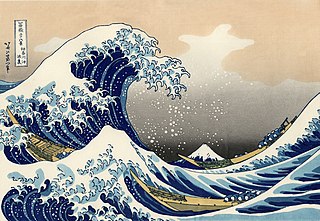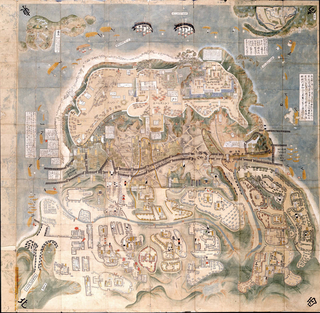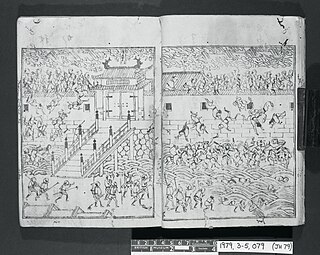
Edo, also romanized as Jedo, Yedo or Yeddo, is the former name of Tokyo.

The Tokugawa shogunate, also known as the Edo shogunate, was the military government of Japan during the Edo period from 1603 to 1868.

The Edo period, also known as the Tokugawa period, is the period between 1603 and 1868 in the history of Japan, when Japan was under the rule of the Tokugawa shogunate and the country's 300 regional daimyo. Emerging from the chaos of the Sengoku period, the Edo period was characterized by economic growth, strict social order, isolationist foreign policies, a stable population, overall peace, and popular enjoyment of arts and culture, colloquially referred to as Ōedo.

Yamanashi Prefecture is a prefecture of Japan located in the Chūbu region of Honshu. Yamanashi Prefecture has a population of 817,192 and has a geographic area of 4,465 km2. Yamanashi Prefecture borders Saitama Prefecture to the northeast, Nagano Prefecture to the northwest, Shizuoka Prefecture to the southwest, Kanagawa Prefecture to the southeast, and Tokyo to the east.

Ōta Dōkan, also known as Ōta Sukenaga, was a Japanese samurai lord, poet and Buddhist monk. He took the tonsure as a Buddhist priest in 1478, and he also adopted the Buddhist name, Dōkan, by which he is known today. Dōkan is best known as the architect and builder of Edo Castle in what is today modern Tokyo; and he is considered the founder of the castle town which grew up around that Ōnin era fortress.

Tokyo Bay is a bay located in the southern Kantō region of Japan spanning the coasts of Tokyo, Kanagawa Prefecture, and Chiba Prefecture. Tokyo Bay is connected to the Pacific Ocean by the Uraga Channel. The Tokyo Bay region is the most populous and the largest industrialized area in Japan.

The Shimabara Rebellion, also known as the Shimabara-Amakusa Rebellion or Shimabara-Amakusa Ikki (島原・天草一揆), was an uprising that occurred in the Shimabara Domain of the Tokugawa shogunate in Japan from 17 December 1637 to 15 April 1638.

The history of Tokyo, Japan's capital prefecture and largest city, starts with archeological remains in the area dating back around 5,000 years. Tokyo's oldest temple is possibly Sensō-ji in Asakusa, founded in 628. The city's original name, Edo, first appears in the 12th century. From 1457 to 1640, Edo Castle was constructed, and was the city's center. Tokugawa Ieyasu, after finishing his conquest of Honshu in 1600, chose Edo as a new capital. Japan's monarchy at Kyoto became a symbolic entity, as the country's real power was given to Edo's Tokugawa Shogunate. By the 1650s, it became Japan's largest city, and by 1720, it was the world's largest. The Great Fire of Meireki in 1657 killed around 108,000 people.

Kichijōji (吉祥寺) is a neighborhood in the city of Musashino in Western Tokyo, Japan. It is centered on a compact but popular commercial area to the north and south of Kichijoji Station, with a full range of shops, restaurants, bars, and coffee houses. The area is a popular center for shopping and leisure in the Tokyo metropolitan area due in part to its close proximity to Inokashira Park and Inokashira Park Zoo.

The Tama River is a major river in Yamanashi, Kanagawa and Tokyo Prefectures on Honshū, Japan. It is officially classified as a Class 1 river by the Japanese government. It is 138 kilometres (86 mi) long, and has a 1,240 square kilometres (480 sq mi) basin.

The Tone River is a river in the Kantō region of Japan. It is 322 kilometers (200 mi) in length and has a drainage area of 16,840 square kilometers (6,500 sq mi). It is nicknamed Bandō Tarō ; Bandō is an obsolete alias of the Kantō Region, and Tarō is a popular given name for an oldest son. It is regarded as one of the "Three Greatest Rivers" of Japan, the others being the Yoshino in Shikoku and the Chikugo in Kyūshū.

This is the glossary of Japanese history including the major terms, titles and events the casual reader might find useful in understanding articles on the subject.

Inokashira Park is a park which straddles Musashino and Mitaka in western Tokyo, Japan. Inokashira Pond (井の頭池) and the Kanda River water source, established during the Edo period, are the primary sources of the Kanda River.

The Satsuma Domain, briefly known as the Kagoshima Domain, was a domain (han) of the Tokugawa shogunate of Japan during the Edo period from 1602 to 1871.

Abe Masahiro was the chief senior councilor (rōjū) in the Tokugawa shogunate of the Bakumatsu period at the time of the arrival of Commodore Matthew Perry on his mission to open Japan to the outside world. Abe was instrumental in the eventual signing of the Convention of Kanagawa in 1854. Abe did not sign the treaty himself or participate in the negotiations in person; this was done by his plenipotentiary Hayashi Akira. His courtesy title was Ise-no-kami.
Edo machi-bugyō (江戸町奉行) were magistrates or municipal administrators with responsibility for governing and maintaining order in the shogunal city of Edo. Machi-bugyō were samurai officials of the Tokugawa shogunate in Edo period Japan. Appointments to this prominent office were usually hatamoto, this was amongst the senior administrative posts open to those who were not daimyōs. Conventional interpretations have construed these Japanese titles as "commissioner", "overseer" or "governor."

The 1855 Edo earthquake, was the third Ansei Great Earthquake, which occurred during the late-Edo period. It occurred after the 1854 Nankai earthquake, which took place about a year prior. The earthquake occurred at 22:00 local time on 11 November. It had an epicenter close to Edo, causing considerable damage in the Kantō region from the shaking and subsequent fires, with a death toll of 7,000–10,000 people and destroyed around 14,000 buildings. The earthquake had a magnitude of 7.0 on the surface wave magnitude scale and reached a maximum intensity of XI (Extreme) on the Mercalli intensity scale. The earthquake triggered a minor tsunami.

Tamagawa Aqueduct is a 43 km long Japanese aqueduct located in Tokyo. It was constructed by the Tokugawa shogunate to supply drinking and fire-fighting water from the Tama river to Edo, providing irrigation water around farm villages.

Fires in Edo (江戸), the former name of Tokyo, during the Edo period (1600−1868) of Japan were so frequent that the city of Edo was characterized as the saying "Fires and quarrels are the flowers of Edo" goes. Even in the modern days, the old Edo was still remembered as the "City of Fires" (火災都市).

Senkawa Aqueduct is a 22 km long Japanese aqueduct located in Tokyo.


















